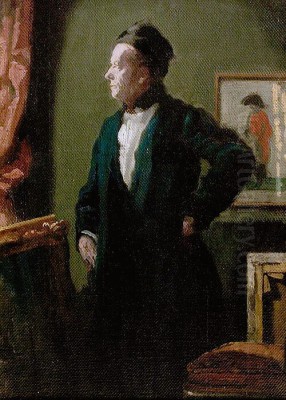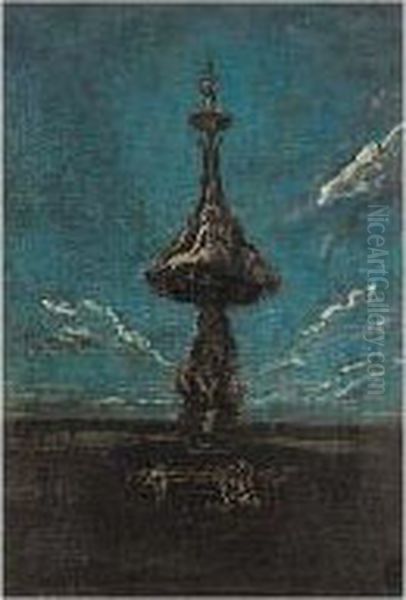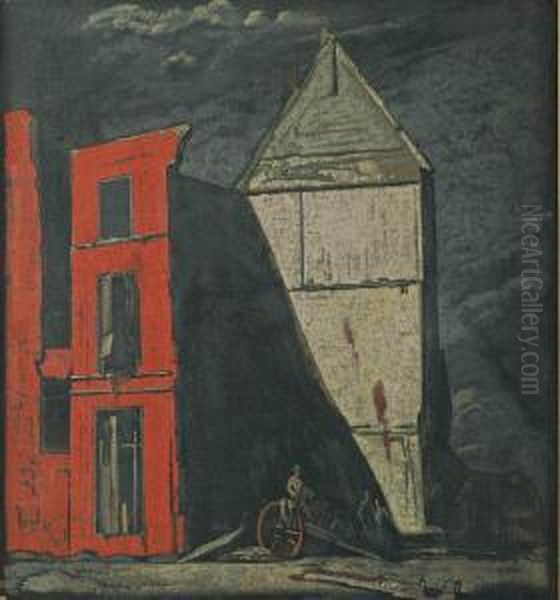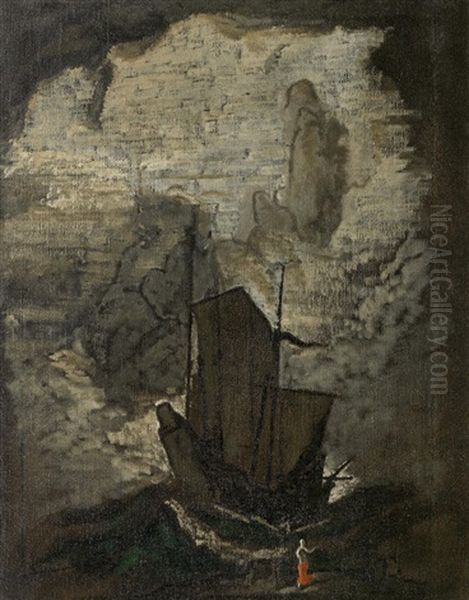
James Ferrier Pryde (1866-1941) stands as a distinctive and somewhat enigmatic figure in the landscape of British art at the turn of the 20th century. A painter and designer of Scottish origin, Pryde is celebrated for two primary contributions: his groundbreaking poster designs created in collaboration with his brother-in-law William Nicholson under the pseudonym "J. & W. Beggarstaff," and his later, deeply personal oil paintings characterized by their dramatic architectural subjects, brooding atmospheres, and profound sense of melancholy. Though perhaps not as widely known as some of his contemporaries, Pryde's unique vision and influential, albeit brief, foray into graphic design left an indelible mark on the art world.
Early Life and Formative Influences in Edinburgh
Born on March 30, 1866, in Edinburgh, James Ferrier Pryde was the only son of David Pryde, a distinguished scholar and headmaster of the Edinburgh Ladies' College, and Barbara Lauder, whose family, the Beugos (originally Bougard from France), had artistic connections. Notably, John Beugo (1759-1841), a relative, was a respected Edinburgh engraver known for his work with the poet Robert Burns. This familial link to the arts, coupled with the pervasive historical and romantic atmosphere of old Edinburgh, with its towering tenements, shadowy closes, and dramatic skylines, undoubtedly seeped into Pryde's young imagination, planting the seeds for his later artistic preoccupations.
Pryde received his early education at George Watson's College. His formal art training commenced at the Royal Scottish Academy School, though he was reportedly an indifferent student, perhaps already chafing against academic conventions. The city of Edinburgh itself, with its dramatic topography and rich, often dark, history, served as a powerful, if informal, tutor. The city's architecture, a blend of medieval and classical, often imbued with a sense of decaying grandeur, would become a recurring motif in his mature work, reflecting what one source described as a "melancholy romanticism of old Edinburgh."

Around 1888, seeking broader artistic horizons, Pryde briefly attended the Académie Julian in Paris for about three months. This period, though short, would have exposed him to the vibrant Parisian art scene, then a crucible of innovation with artists like Henri de Toulouse-Lautrec and Pierre Bonnard pushing the boundaries of painting and graphic arts. However, Pryde's Parisian experience seems not to have fundamentally altered his artistic trajectory in the way it did for many of his contemporaries; his core sensibilities remained deeply rooted in his Scottish heritage and a more classical, theatrical vision.
The Beggarstaff Brothers: Revolutionizing Poster Design
Returning to Britain, Pryde's career took a pivotal turn when he met the artist William Nicholson. Nicholson would later marry Pryde's sister, Mabel, in 1893, cementing a personal and professional bond. Around this time, from 1893 or 1894 until 1899, Pryde and Nicholson embarked on a remarkable artistic partnership, adopting the pseudonym "J. & W. Beggarstaff" (or sometimes "Beggarstaffs"). The name was reputedly chosen at random after seeing it on a sack of corn in an old stable.
Under this moniker, they produced a series of posters that were revolutionary for their time. The Beggarstaffs' approach was characterized by a radical simplification of form, the use of bold, flat areas of color (often muted), strong silhouettes, and an innovative use of negative space. Their technique often involved cutting shapes from colored paper and pasting them onto a background, a method akin to collage, which allowed for sharp, clean lines and a striking graphic impact. This was a stark departure from the more ornate and illustrative style prevalent in much of Victorian and Art Nouveau poster design, exemplified by artists like Jules Chéret.
Their posters, though not always commercially successful due to their avant-garde nature, were highly influential among fellow artists and designers. Notable works include their poster for a production of Hamlet (c. 1894), featuring a stark, shadowy figure of the prince; one for Don Quixote (c. 1895) commissioned by Sir Henry Irving for a Lyceum Theatre production (though ultimately unused); and commercial designs such as Rowntree's Elect Cocoa (c. 1896) and Kassama Corn Flour. These designs prioritized atmosphere and immediate visual impact over detailed representation, prefiguring many aspects of 20th-century graphic design.
The Beggarstaffs' work was admired by artists like Aubrey Beardsley and had a significant impact on the development of poster art in Britain and continental Europe, influencing the Plakatstil (Poster Style) in Germany. Despite their artistic acclaim, the partnership was short-lived, dissolving around 1899 due to a lack of consistent commercial commissions and perhaps differing artistic ambitions. Nicholson went on to achieve considerable success as a painter and printmaker, while Pryde increasingly turned his attention to oil painting.
Pryde's Independent Artistic Voice: The Architectural Fantasies

After the dissolution of the Beggarstaff partnership, James Pryde focused on developing his unique vision in oil painting. He became known for his large, imposing canvases depicting architectural subjects, often imbued with a profound sense of drama, mystery, and melancholy. These were not straightforward topographical representations but rather imaginative constructions, often referred to as "architectural fantasies" or "dramatic compositions."
His subjects frequently included towering, dilapidated buildings, shadowy archways, deserted courtyards, and monumental ruins, often dwarfing the small, solitary human figures that occasionally populated them. These figures, when present, seem insignificant against the backdrop of overwhelming architectural forms, enhancing the sense of loneliness, human frailty, or impending doom. Works like The Slum, The Monument, The Red Ruin, and The Human Comedy exemplify this thematic concern.
One of his most celebrated paintings is Construction (c. 1910-18, though some sources date it earlier). This work, typical of his mature style, depicts a vast, shadowed archway or scaffold structure, with a lone, diminutive figure beneath. The composition is powerful, relying on strong contrasts of light and dark, and a restricted, somber palette. The painting evokes a sense of grandeur and decay, a stage for some unseen, perhaps tragic, human drama. It is considered an important work in early modern British painting.
Pryde's paintings often suggest a theatrical setting, an influence perhaps stemming from his early, albeit brief, experience as an actor with Edward Gordon Craig's company. Craig, a visionary theatre designer and son of the famous actress Ellen Terry, shared Pryde's interest in dramatic space and simplified, monumental forms. Pryde's compositions often feel like stage sets for plays of an epic or tragic nature, hinting at narratives without explicitly defining them.
Artistic Style and Thematic Concerns
James Pryde's artistic style is highly individual and instantly recognizable. His paintings are characterized by a powerful sense of monumentality and a dramatic use of chiaroscuro – the interplay of light and shadow. He favored a limited palette, often dominated by dark browns, ochres, grays, and blacks, though these somber tones could imply rich, underlying color. His brushwork was broad and expressive, contributing to the overall atmospheric effect rather than focusing on minute detail.

The recurring theme in Pryde's work is the grandeur and often the decay of architecture, and its psychological impact. His buildings are not merely backdrops but active participants in the drama, imbued with personality and history. They can appear menacing, melancholic, or awe-inspiring. The human element, when included, serves to emphasize the scale of the architecture and the insignificance or vulnerability of individuals within these overwhelming environments. This creates a mood of introspection, solitude, and sometimes a subtle sense of unease or foreboding.
His fascination with ruins and the passage of time connects him to the Romantic tradition, but his stark compositions and psychological intensity also align him with more modern sensibilities. There is a timeless quality to his architectural visions; they seem to exist outside of a specific historical period, evoking a universal sense of human experience in the face of overwhelming forces or structures.
Influences and Contemporaries
Pryde's artistic lineage can be traced to several key influences. The 18th-century Italian artist Giovanni Battista Piranesi, known for his dramatic etchings of Roman ruins (Carceri d'invenzione or "Imaginary Prisons"), is an obvious precursor. Pryde shared Piranesi's fascination with monumental scale, crumbling architecture, and the dramatic potential of deep shadows and complex perspectives.
The Spanish master Diego Velázquez was another profound influence, particularly in his use of somber color palettes, dignified compositions, and the ability to convey psychological depth. Pryde admired Velázquez's painterly qualities and the gravitas he brought to his subjects. The French satirist and painter Honoré Daumier, with his expressive figures and dramatic use of light, also resonated with Pryde's artistic temperament.
Among his British contemporaries, Pryde occupied a unique niche. While artists like Walter Sickert and the Camden Town Group were exploring urban realism and the grittier aspects of modern life, Pryde's vision was more romantic and theatrical, though often equally somber. He was less concerned with direct social commentary than with evoking a mood and a sense of timeless drama. His work can also be seen in relation to the tonal harmonies and atmospheric concerns of James McNeill Whistler, an artist who had a significant impact on British art in the late 19th century.
Although the Beggarstaffs' poster work was avant-garde, Pryde's painting style remained largely independent of the major modernist movements like Cubism or Fauvism that were developing in Europe during his career. He carved out his own path, drawing on historical precedents while infusing them with a distinctly personal and modern sensibility. Other notable artists of his era include the Scottish architect and designer Charles Rennie Mackintosh, whose innovative approach to form, though in a different field, shared a certain boldness, and the Glasgow Boys, a group of painters who brought a new vibrancy to Scottish art.
Pryde was a member of the International Society of Sculptors, Painters and Gravers, an organization founded by Whistler, which provided a platform for more progressive artists. However, despite his talent and the respect he garnered from fellow artists, Pryde never achieved widespread popular or official acclaim during his lifetime. He was, for instance, never elected to the Royal Academy, perhaps because his brooding, unconventional style did not align with the institution's more conservative tastes. This lack of broader recognition contributed to his somewhat marginalized status in art historical narratives for a time.
Personal Life and Character
James Pryde married the musician Marian Symons in 1900, and they had a daughter. His earlier connection to the Nicholson family through his sister Mabel (who married William Nicholson and was herself an artist) placed him within an artistic and bohemian circle. Mabel Pryde, for example, often painted charming studies of her children.
Pryde himself was described as a striking figure, tall and imposing, with a personality that could be both charming and somewhat aloof. He possessed a keen wit and was known for his engaging conversation. Sources suggest he was a sociable man, enjoying the company of friends and often hosting gatherings. However, his later life was marked by personal struggles, including periods of ill health and financial difficulty. He became increasingly reclusive and his artistic output dwindled significantly in his final decades.
There's an anecdote mentioned in the provided information about Robert Louis Stevenson deeply mourning a "Pryde's" death. Given Stevenson died in 1894, this likely refers to James's father, David Pryde, a prominent Edinburgh intellectual, rather than James himself, who outlived Stevenson by many years. This highlights the intellectual and cultural milieu from which James Pryde emerged.
His passion for the dramatic extended beyond his canvases. He had a lifelong interest in the theatre and even designed some stage sets. This theatrical sensibility is a defining characteristic of his art, where every scene feels carefully staged for maximum emotional impact.
Later Years and Legacy
Despite the early promise and the critical success of the Beggarstaff posters, James Pryde's later career was not one of consistent triumph. He produced relatively few paintings after the 1920s, and his work, while admired by a select group of connoisseurs and fellow artists, remained somewhat outside the mainstream. His health declined, and he struggled with alcoholism in his later years. James Ferrier Pryde died in London on February 24, 1941.
His legacy, however, endures. The Beggarstaff Brothers' posters are now recognized as landmarks in the history of graphic design, celebrated for their modernity and bold innovation. His paintings, though fewer in number than one might expect from a career spanning several decades, possess a unique and powerful vision. They continue to fascinate viewers with their brooding atmosphere, monumental scale, and enigmatic narratives.
Pryde can be considered an "artist's artist," one whose work was perhaps more appreciated by his peers than by the general public or official institutions of his time. His influence can be seen in the work of subsequent stage designers and painters who were drawn to dramatic and atmospheric effects. Artists like John Piper, known for his depictions of British architecture and landscapes, particularly during World War II, show a kindred spirit in their romantic and often somber portrayal of buildings.
Today, James Ferrier Pryde's works are held in major public collections, including the Tate Britain, the National Galleries of Scotland, and the Ashmolean Museum in Oxford. Exhibitions of his work, though infrequent, help to re-evaluate his contribution and introduce his compelling vision to new audiences. He remains a testament to an artist who, while perhaps not prolific, pursued a singular and deeply personal artistic path, creating images of haunting beauty and enduring power. His exploration of architectural grandeur and human insignificance, rendered with such dramatic intensity, secures his place as a unique voice in British art.